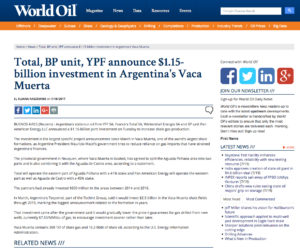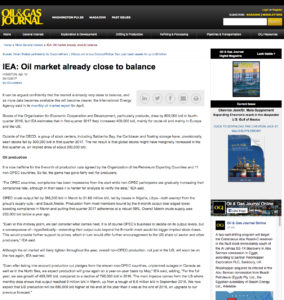Argentina: Doubling shale gas production in five years 08/30/18 • bit.ly/2On2Qgp
 “We are not going to stop until we export US$ 30 billion in gas and oil from Vaca Muerta,” said Argentina president Mauricio Macri.
“We are not going to stop until we export US$ 30 billion in gas and oil from Vaca Muerta,” said Argentina president Mauricio Macri.
 “We are not going to stop until we export US$ 30 billion in gas and oil from Vaca Muerta,” said Argentina president Mauricio Macri.
“We are not going to stop until we export US$ 30 billion in gas and oil from Vaca Muerta,” said Argentina president Mauricio Macri.
 Argentina’s state-run oil firm YPF, France’s Total, Wintershall Energía and BP unit Pan American Energy has announced a $1.15-billion joint investment to increase shale gas production in Vaca Muerta, one of the world’s largest shale formations.
Argentina’s state-run oil firm YPF, France’s Total, Wintershall Energía and BP unit Pan American Energy has announced a $1.15-billion joint investment to increase shale gas production in Vaca Muerta, one of the world’s largest shale formations.
 US crude exports averaged more than 1 million barrels a day in April, driven by the significant discount of US crude prices relative to global benchmarks. New infrastructure, like the 520,000 barrels a day Dakota Access Pipeline, has reduced costs to move crude to the Gulf Coast, while major projects are underway at US Gulf Coast ports that will increase the region’s export capacity. These outward flows have served as an outlet for rising US crude production and have displaced other barrels that have struggled to then find a home.
US crude exports averaged more than 1 million barrels a day in April, driven by the significant discount of US crude prices relative to global benchmarks. New infrastructure, like the 520,000 barrels a day Dakota Access Pipeline, has reduced costs to move crude to the Gulf Coast, while major projects are underway at US Gulf Coast ports that will increase the region’s export capacity. These outward flows have served as an outlet for rising US crude production and have displaced other barrels that have struggled to then find a home.
 The worst crude-market crash in a generation has propelled energy companies into the digital world. Now they’re using DNA sequencing to track crude molecules and mapping buried streams with imaging software. Robots are fitting pipes together. Roughnecks consult mobile apps for drilling-direction advice. Algorithms adjust the extraction flow based on computer monitoring hundreds of feet below. “You’ve had a clear shift occur where onshore North America for the first time in recent history has become a technology play.” said Tom Curran, an energy analyst at FBR Capital Markets.
The worst crude-market crash in a generation has propelled energy companies into the digital world. Now they’re using DNA sequencing to track crude molecules and mapping buried streams with imaging software. Robots are fitting pipes together. Roughnecks consult mobile apps for drilling-direction advice. Algorithms adjust the extraction flow based on computer monitoring hundreds of feet below. “You’ve had a clear shift occur where onshore North America for the first time in recent history has become a technology play.” said Tom Curran, an energy analyst at FBR Capital Markets.
 Now is the halfway point for the 6-month oil production cuts agreed by OPEC and the 11 other oil producing countries, and the market is very close to balance. The International Energy Agency has observed that “Even at this midway point, we can consider what comes next … extending their output cuts beyond the 6-month mark would be bigger implied stock draws. This would provide further support to prices, which in turn would offer further encouragement to the US shale oil sector and other producers.”
Now is the halfway point for the 6-month oil production cuts agreed by OPEC and the 11 other oil producing countries, and the market is very close to balance. The International Energy Agency has observed that “Even at this midway point, we can consider what comes next … extending their output cuts beyond the 6-month mark would be bigger implied stock draws. This would provide further support to prices, which in turn would offer further encouragement to the US shale oil sector and other producers.”
A turnaround for Venezuela’s oil industry, which provides about 95% of the country’s foreign currency earnings, would take at least two years under the best of circumstances. Any hope of reversing Venezuela’s decline as an oil supplier would mean that the country would have to settle debts with oil-service providers, fix fraying infrastructure and, potentially, get foreign companies to operate some fields. Venezuela has depended on loans from China and Russia in recent years for liquidity, but is finding it harder and harder to obtain financing, and debt service is becoming more burdensome.
Some 1.5 million of an agreed upon 1.8 million barrels per day of oil has been taken out of the market in January, Saudi Energy Minister Khalid al-Falih said. He noted, however, that at the same time shale oil is estimated to grow this year at 200,000 to 300,000 barrels per day – not at the 500,000 bpd estimated by the International Energy Agency. Al-Falih indicated that OPEC countries could cut oil production again this year if higher prices were not maintained due to reasons beyond the control of producers, including falling demand.
China’s production is forecast to fall by as much as 7 percent this year, extending a record decline in 2016. This is about the same size as the recent output cut agreed by OPEC member Iraq. China’s output slumped in 2016 as state-owned firms shut wells at mature fields that had become too costly to operate after the crash. Crude production fell 6.9 percent in the first 11 months of 2016 to about 4 million barrels a day, the first decline since 2009 and the biggest in data going back to 1990.
![]() U.S. field production of crude oil increased in 2015 for the seventh consecutive year, reaching 9.42 million barrels per day. This was the highest crude oil production level since 1972. In 2015, production gains were highest in Texas, the Gulf of Mexico, and North Dakota, as these three regions accounted for 77% of the country’s total increase. Although annual production for 2015 grew, monthly U.S. crude oil production has declined since April 2015. Lower oil prices led to slower development activity, and production fell to 8.74 million b/d in August 2016.
U.S. field production of crude oil increased in 2015 for the seventh consecutive year, reaching 9.42 million barrels per day. This was the highest crude oil production level since 1972. In 2015, production gains were highest in Texas, the Gulf of Mexico, and North Dakota, as these three regions accounted for 77% of the country’s total increase. Although annual production for 2015 grew, monthly U.S. crude oil production has declined since April 2015. Lower oil prices led to slower development activity, and production fell to 8.74 million b/d in August 2016.
![]() OEF REVIEW:China’s crude oil output is at a 6-year low as the country’s state-run energy companies continued to pump less from aging, high-cost fields. Production during August dropped 9.9 percent and during the first eight months of the year output dropped 5.7 percent. The country is forecast to lead production declines across Asia, helping tighten the global market as the world’s largest consuming region relies more on overseas supplies. China’s imports rebounded last month to the highest since April. Nomura Holdings Inc. in Hong Kong pointed out that ”China’s crude output won’t see an apparent rebound unless Brent recovers to $60 a barrel level, as most of China’s aging oilfields can’t make a profit below this price,” adding that ”Massive capital expenditure cuts have translated to more oil supply destruction.”
OEF REVIEW:China’s crude oil output is at a 6-year low as the country’s state-run energy companies continued to pump less from aging, high-cost fields. Production during August dropped 9.9 percent and during the first eight months of the year output dropped 5.7 percent. The country is forecast to lead production declines across Asia, helping tighten the global market as the world’s largest consuming region relies more on overseas supplies. China’s imports rebounded last month to the highest since April. Nomura Holdings Inc. in Hong Kong pointed out that ”China’s crude output won’t see an apparent rebound unless Brent recovers to $60 a barrel level, as most of China’s aging oilfields can’t make a profit below this price,” adding that ”Massive capital expenditure cuts have translated to more oil supply destruction.”
Nimble U.S. shale oil producers continue to show an uncanny ability to squeeze more and more crude from new wells, allowing them to do more with less as they try to weather another dip in oil prices to $40 a barrel, so they are still seeing output gains from improved well designs and fracking techniques. The pace of innovation is increasing. Pioneer Natural Resources said it was introducing its third generation of well completion techniques, called version 3.0, using even more sand and water than the super-sized volumes introduced as version 2.0 earlier in the price crash to pull more oil out of rock. For its part, Devon Energy Corp has cut costs to drill and complete new wells by 40 percent and plans to cut $1 billion in costs this year.
![]() OEF REVIEW:According to the U.S. Energy Information Administration (EIA) world tight oil production is expected to more than double between 2015 and 2040, increasing from 4.98 million barrels per day in 2015 to 10.36 million barrels per day in 2040. Most of the projected increase will come from the United States, with much of the rest coming from countries such as Russia, Canada, and Argentina. U.S. tight oil production is expected to reach 7.1 million barrels per day in 2040. Tight oil production in Canada will continue to decline until 2020, and then increase over the rest of the projection period, reaching 0.76 million barrels per day in 2040. Argentina is still in the early stages of commercial tight oil production, but projections are that production will double from 2015 to 2020 and will reach 0.69 million b/d in 2040. Russia, Mexico, Colombia, Australia, and other countries that hold large technically recoverable tight oil resources are expected to contribute 18% of the projected total world tight oil production by 2040.
OEF REVIEW:According to the U.S. Energy Information Administration (EIA) world tight oil production is expected to more than double between 2015 and 2040, increasing from 4.98 million barrels per day in 2015 to 10.36 million barrels per day in 2040. Most of the projected increase will come from the United States, with much of the rest coming from countries such as Russia, Canada, and Argentina. U.S. tight oil production is expected to reach 7.1 million barrels per day in 2040. Tight oil production in Canada will continue to decline until 2020, and then increase over the rest of the projection period, reaching 0.76 million barrels per day in 2040. Argentina is still in the early stages of commercial tight oil production, but projections are that production will double from 2015 to 2020 and will reach 0.69 million b/d in 2040. Russia, Mexico, Colombia, Australia, and other countries that hold large technically recoverable tight oil resources are expected to contribute 18% of the projected total world tight oil production by 2040.
Oil’s rebound from the lowest level in more than 12 years may face an abrupt halt as prices near a level that could trigger a wave of new U.S. shale production. Futures in New York have advanced more than 60% since the February low and closed at $43.73 a barrel Friday 22nd March, the highest in five months, nearing a $45-level IG Ltd. says makes some shale plays profitable. Drilled, uncompleted wells could return 500,000 barrels of oil per day back to the market, according to Richard Westerdale, a director at the U.S. State Department’s Bureau of Energy Resources. The inventory of wells is known as the fraclog. “Once we start approaching $45 and above, the risk of a much sharper pullback starts to increase as a lot of shale becomes profitable again,” Angus Nicholson, an analyst at IG in Melbourne, said by phone.
![]() OEF REVIEW:China’s crude imports will rise further from a record this year to feed its expanding refining sector and strategic reserves, according to Standard Chartered Bank. The nation’s average crude imports will rise by as much as 600,000 barrels per day this year, analysts including Priya N. Balchandani said in a March 24th report. Imports last month surged above 8 million barrels per day for the first time and exceeded volumes shipped to the U.S., the world’s top oil user, according to the bank. Standard Chartered expects China’s crude imports will top 10 million barrels per day by late 2018 or early 2019.
OEF REVIEW:China’s crude imports will rise further from a record this year to feed its expanding refining sector and strategic reserves, according to Standard Chartered Bank. The nation’s average crude imports will rise by as much as 600,000 barrels per day this year, analysts including Priya N. Balchandani said in a March 24th report. Imports last month surged above 8 million barrels per day for the first time and exceeded volumes shipped to the U.S., the world’s top oil user, according to the bank. Standard Chartered expects China’s crude imports will top 10 million barrels per day by late 2018 or early 2019.
![]() OEF REVIEW:Oil prices have climbed by about 50 percent from their February lows, topping $40 per barrel. But the rally could be reaching its limits, at least temporarily, as persistent oversupply and the prospect of new shale production caps any potential price increase.
OEF REVIEW:Oil prices have climbed by about 50 percent from their February lows, topping $40 per barrel. But the rally could be reaching its limits, at least temporarily, as persistent oversupply and the prospect of new shale production caps any potential price increase.
![]() OEF REVIEW:Barclays has revised downwards its global exploration and production spending outlook for 2016, now saying such spending could fall 27% this year, down from 15% back in January. Spending in North America is now trending down 40% versus 27% in January, and international spending is down 21% year-over-year. Since the Barclays Upstream Spending Survey published in January, operators representing 71% of total spending have revised budgets to reflect reduced 2016 spending plans amid a sustained lower oil-price outlook.
OEF REVIEW:Barclays has revised downwards its global exploration and production spending outlook for 2016, now saying such spending could fall 27% this year, down from 15% back in January. Spending in North America is now trending down 40% versus 27% in January, and international spending is down 21% year-over-year. Since the Barclays Upstream Spending Survey published in January, operators representing 71% of total spending have revised budgets to reflect reduced 2016 spending plans amid a sustained lower oil-price outlook.
![]() OEF REVIEW:The Liard Basin is a lightly drilled region at about 60°N that straddles the boundaries of the Northwest Territories, Yukon, and the province of British Columbia. It is located at the far northwest corner of the Western Canada Sedimentary Basin, Canada’s major oil and gas producing area…
OEF REVIEW:The Liard Basin is a lightly drilled region at about 60°N that straddles the boundaries of the Northwest Territories, Yukon, and the province of British Columbia. It is located at the far northwest corner of the Western Canada Sedimentary Basin, Canada’s major oil and gas producing area…
![]() OEF REVIEW:U.S. crude oil production from the Lower 48 states from new wells (drilled since the start of 2014) made up 48% of total U.S. crude oil production in 2015, up from 22% in 2007. Production from new wells has grown as advances in horizontal drilling and completion techniques led to growth in oil production from low-permeability tight reservoirs. In 2015, production from tight formations – which include, but are not limited to, shale plays – accounted for more than 4 million barrels per day, or 50% of total U.S. oil production.
OEF REVIEW:U.S. crude oil production from the Lower 48 states from new wells (drilled since the start of 2014) made up 48% of total U.S. crude oil production in 2015, up from 22% in 2007. Production from new wells has grown as advances in horizontal drilling and completion techniques led to growth in oil production from low-permeability tight reservoirs. In 2015, production from tight formations – which include, but are not limited to, shale plays – accounted for more than 4 million barrels per day, or 50% of total U.S. oil production.
![]() OEF REVIEW:U.S. monthly crude oil production in December 2015 continued to decline, as oil production reached its lowest level since November 2014. Production also declined from year-ago levels for the first time in more than four years.
OEF REVIEW:U.S. monthly crude oil production in December 2015 continued to decline, as oil production reached its lowest level since November 2014. Production also declined from year-ago levels for the first time in more than four years.
![]() OEF REVIEW:“We expect legacy assets such as Gorgon will drive long-term growth and create shareholder value for decades to come,” said Chairman and CEO John Watson. “The long-term fundamentals for LNG are attractive, particularly in the Asia-Pacific region, and this is a significant milestone for all involved.”
OEF REVIEW:“We expect legacy assets such as Gorgon will drive long-term growth and create shareholder value for decades to come,” said Chairman and CEO John Watson. “The long-term fundamentals for LNG are attractive, particularly in the Asia-Pacific region, and this is a significant milestone for all involved.”